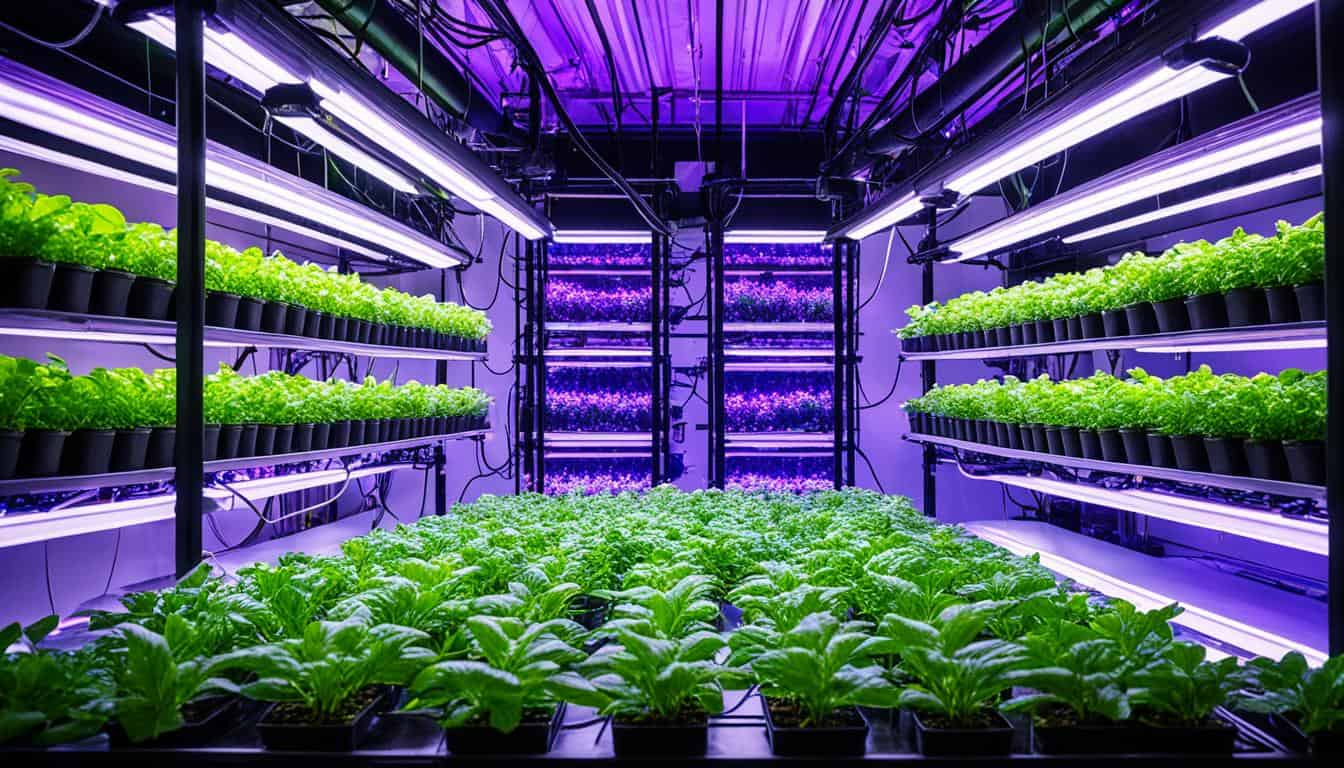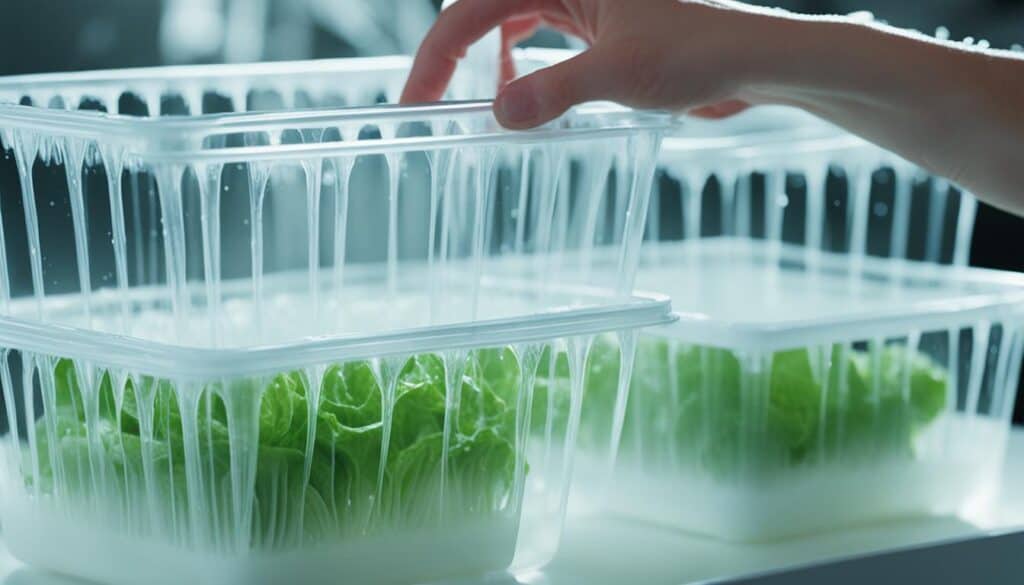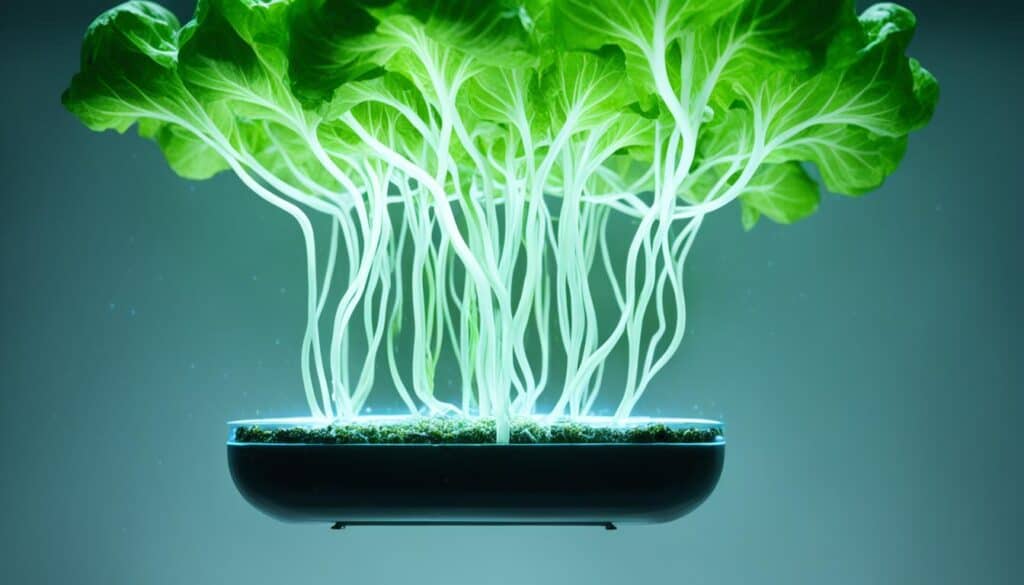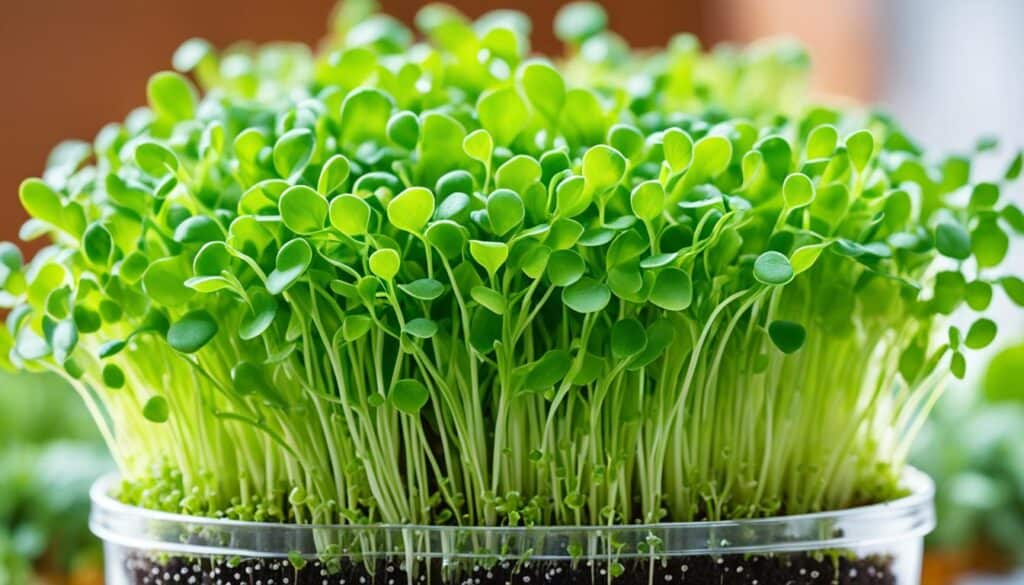Did you know that hydroponic lettuce cultivation uses up to 90% less water compared to traditional soil-based farming methods? It’s true! Hydroponic lettuce is not only a sustainable and efficient way to grow fresh and nutritious greens, but it also offers numerous benefits for indoor lettuce cultivation.
- Hydroponic lettuce cultivation requires significantly less water compared to traditional soil-based farming.
- Indoor lettuce cultivation maximizes space utilization and allows for year-round production.
- Hydroponic systems offer faster growth, higher yield, and reduced water usage for lettuce plants.
- Hydroponic lettuce is free from pesticides and other contaminants, ensuring fresh and safe greens.
- Choosing the right hydroponic system and nutrient solutions is crucial for successful lettuce cultivation.
The Basics of Hydroponic Gardening
Welcome to the fascinating world of hydroponic gardening! In this section, I will introduce you to the fundamentals of this innovative technique that allows you to grow plants without soil. Hydroponic gardening utilizes water-based nutrient solutions to provide plants with all the essential elements they need for robust growth and development. Let’s dive in and explore the various hydroponic systems and the best options for growing lettuce.
Exploring Hydroponic Systems for Lettuce Cultivation
When it comes to hydroponics, there are different systems available, each with its own unique advantages and requirements. Let’s take a closer look at some of the best hydroponic systems for lettuce:
- Kratky Method: The Kratky method is an excellent choice for beginners or those on a budget. It is a passive system that requires no electricity or complex equipment. In this method, you fill a container with a nutrient solution, and the plants grow with their roots immersed in the nutrient-rich water. As the plants consume the nutrients, the water level gradually decreases. The Kratky method is ideal for small-scale lettuce cultivation.
- Nutrient Film Technique (NFT): NFT is a popular hydroponic system that uses a sloping channel to constantly flow a thin film of nutrient solution over the roots. This system provides an efficient oxygen supply to the roots and is suitable for growing lettuce with shallow root systems. NFT requires a continuous flow of nutrient solution and proper channel slope maintenance.
- Deep Water Culture (DWC): The DWC system involves suspending the plant’s roots directly into a nutrient solution reservoir. Oxygen is provided to the roots through air stones or diffusers, ensuring optimal growth and preventing root rot. DWC is a straightforward system that works well for growing lettuce and other leafy greens.
- Aeroponics: Aeroponics is a high-tech hydroponic system that suspends plant roots in the air and mists them with a nutrient solution. This misting process delivers nutrients and oxygen directly to the roots, promoting rapid and efficient growth. Aeroponics is a space-saving system and is suitable for lettuce cultivation.
Choosing the best hydroponic system for lettuce depends on several factors such as available space, budget, and personal preferences. Consider the efficiency, scalability, maintenance requirements, and compatibility with lettuce cultivation before making your decision. Now that you have an overview of the different hydroponic systems, you can determine the one that suits your needs best.
| Hydroponic System | Advantages | Requirements |
|---|---|---|
| Kratky Method | Low-cost, simple setup | No electricity required |
| Nutrient Film Technique (NFT) | Efficient oxygen supply to roots | Continuous flow of nutrient solution |
| Deep Water Culture (DWC) | Straightforward and suitable for lettuce | Oxygen supply to roots with air stones |
| Aeroponics | Rapid and efficient growth | High-tech system, misting of roots |
The table above summarizes the advantages and requirements of each hydroponic system. Use this information as a reference to assist you in selecting the best option for your lettuce cultivation goals.
The Importance of Hydroponic Lettuce Nutrients
In hydroponic lettuce cultivation, providing the right nutrients is crucial for healthy plant growth and optimal crop production. Lettuce requires a specific balance of nutrients to thrive and develop into crisp, flavorful greens. By understanding the essential nutrients needed and how to deliver them in a hydroponic system, you can ensure the success of your lettuce crops.
Essential Nutrients for Hydroponic Lettuce
Lettuce plants require a range of macronutrients and micronutrients to support their growth and development. The primary macronutrients for lettuce are:
- Nitrogen (N)
- Phosphorus (P)
- Potassium (K)
In addition to these macronutrients, lettuce needs secondary macronutrients, including:
- Calcium (Ca)
- Magnesium (Mg)
Furthermore, lettuce requires various micronutrients, such as:
- Iron (Fe)
- Manganese (Mn)
- Zinc (Zn)
These nutrients play vital roles in the growth, development, and overall health of the lettuce plants. Ensuring that the nutrient solution provides an appropriate balance of these elements is essential for maximizing yield and quality.
Monitoring and Adjusting Nutrient Levels
In a hydroponic system, the nutrients are delivered to the plants through the water in the form of a nutrient solution. Monitoring and adjusting the nutrient levels in the solution is crucial to meet the changing demands of the lettuce plants throughout their growth cycle.
Ideally, you should regularly test the nutrient solution using a pH and conductivity meter, as well as a nutrient testing kit. These tools will help you assess the nutrient concentration, pH level, and overall quality of the solution. Based on the test results, you can make necessary adjustments by adding specific nutrients or adjusting the pH level to maintain an optimal growing environment for the lettuce plants.
Tip: It’s important to remember that nutrient requirements may vary depending on the lettuce variety and growth stage. Be sure to follow the guidelines provided by your hydroponic nutrient solution manufacturer and consult resources specific to the lettuce varieties you are cultivating.
By carefully monitoring and adjusting the nutrient levels, you can provide the lettuce plants with the essential elements they need for robust growth, vibrant color, and excellent flavor.
Hydroponic Lettuce Nutrient Solution Example
| Nutrient | Concentration (ppm) |
|---|---|
| Nitrogen (N) | 120 – 150 |
| Phosphorus (P) | 80 – 100 |
| Potassium (K) | 200 – 250 |
| Calcium (Ca) | 120 – 150 |
| Magnesium (Mg) | 50 – 80 |
| Iron (Fe) | 2 – 5 |
| Manganese (Mn) | 2 – 5 |
| Zinc (Zn) | 0.05 – 0.1 |
These concentration ranges are for reference purposes and may vary based on specific lettuce cultivars and growing conditions. It is important to adjust the nutrient solution according to the specific requirements of your lettuce plants.
Key Takeaways
Hydroponic lettuce nutrients are essential for healthy plant growth and optimal crop production. By providing the right balance of macronutrients and micronutrients, you can ensure that your lettuce plants thrive throughout their growth cycle. Regular monitoring and adjustment of the nutrient solution’s pH and nutrient levels are crucial for maintaining an ideal growing environment and maximizing the yield and quality of your hydroponic lettuce.
The Benefits of Sustainable Farming with Hydroponics
When it comes to sustainable farming practices, hydroponics is at the forefront. This innovative technique offers numerous benefits, not only for the environment but also for consumers like you. Hydroponic lettuce cultivation, in particular, stands out as a prime example of sustainable farming with hydroponics. Let’s delve into the advantages that hydroponic lettuce brings to the table.
Water Efficiency and Conservation
One of the key benefits of hydroponic lettuce cultivation is its exceptional water efficiency. Unlike traditional soil-based farming methods, hydroponics uses a closed-loop system where water is recycled and reused. This means that hydroponic lettuce requires significantly less water, making it a sustainable choice for water conservation. By opting for hydroponic lettuce, you contribute to preserving this precious resource for future generations.
Eco-Friendly and Pesticide-Free
Hydroponic lettuce is grown without the need for pesticides or herbicides. In a controlled environment, pests have limited access to the plants, reducing the risks associated with chemical pesticide use. By choosing hydroponic lettuce, you can enjoy a healthier and pesticide-free option while minimizing the negative impact on the environment.
Urban Farming and Reduced Carbon Footprint
Hydroponic systems can be set up in urban areas, bringing farming closer to consumers and reducing the need for long-distance transportation. This localized approach to food production minimizes the carbon footprint associated with transportation and distribution. By adopting hydroponic lettuce cultivation in urban settings, we can make a significant positive impact on our environment.
By adopting sustainable farming practices like hydroponics, we can ensure a greener and healthier future. Hydroponic lettuce cultivation exemplifies the potential of sustainable agriculture, offering water efficiency, pesticide-free produce, and reduced carbon footprint through urban farming. So, why not embrace this innovative method and indulge in the fresh, crisp, and environmentally conscious delights of hydroponic lettuce?
Choosing the Right Containers for Hydroponic Lettuce
When it comes to growing hydroponic lettuce, selecting the appropriate containers is crucial for ensuring a successful cultivation. The right container can provide the ideal environment for your lettuce plants to thrive and maximize their yield. Let’s explore some options:
Glass Jars
Glass jars, such as mason jars or large glass bottles, can be a charming and cost-effective choice for hydroponic lettuce containers. They provide excellent visibility, allowing you to observe the growth of the roots and monitor the water levels easily. Glass jars also create a unique aesthetic appeal, adding a touch of elegance to your indoor garden.
Plastic Containers
Plastic containers are widely available and come in various shapes and sizes, making them a versatile option for hydroponic lettuce cultivation. Look for containers with good drainage holes to prevent waterlogging and ensure adequate air circulation around the roots. Opt for food-grade plastic containers that are safe and durable for your lettuce plants.
Specialized Hydroponic Grow Trays
For a more professional and specialized approach, consider using hydroponic grow trays. These trays are specifically designed for hydroponic gardening and provide optimal conditions for lettuce growth. They often come with built-in features such as a drainage system and a reservoir for nutrient solution. Hydroponic grow trays offer convenience and efficiency, making them a popular choice among experienced hydroponic gardeners.
Additionally, regardless of the container you choose, there are a few essential factors to keep in mind:
- Ensure the containers have good drainage to prevent waterlogging and root rot.
- Provide adequate air circulation around the roots to promote healthy growth.
- Use clear or translucent containers to allow visibility of the water and root system.
- Consider painting the containers with a dark color to block light and prevent algae growth.
By selecting the right containers for your hydroponic lettuce, you can create an optimal growing environment that will support the growth and development of healthy, vibrant plants.
Prepping Your Containers for Hydroponic Lettuce
Before I start growing hydroponic lettuce in my containers, I need to make sure they are properly prepped. Here’s what I need to do:
Rinse the Containers
The first step is to rinse the containers thoroughly to remove any dirt or residue. This will ensure that the lettuce plants have a clean and healthy environment to grow in.
Paint Clear Containers
If I’m using clear containers for hydroponic lettuce, I can paint them with a dark color, such as black, to prevent algae growth by blocking light. I should use a paint specifically formulated for plastic or glass surfaces.
Apply Two Coats of Paint
When painting the containers, I need to cover them evenly with two coats of paint. It’s important to allow each coat to dry before applying the next to ensure a smooth and even finish.
Create a Clear Sightline
After painting, I should remove any taped markings on the containers. This will create a clear sightline for monitoring water levels and root growth, allowing me to easily keep track of the plants’ progress.
By properly prepping my hydroponic lettuce containers, I can create an ideal growing environment for my plants and set them up for success.
“Properly prepping your containers is crucial for the success of your hydroponic lettuce cultivation.”
Growing Hydroponic Lettuce with the Kratky Method
The Kratky method is a popular and cost-effective way to grow hydroponic lettuce without the need for electricity or complex equipment. It offers a simple and efficient solution for maximizing your lettuce yield while minimizing maintenance and costs.
The Kratky method involves placing lettuce plants in containers filled with a nutrient solution. The water level is initially high, allowing the plants’ roots to access the nutrients they need for growth. As the plants consume nutrients, the water level gradually decreases naturally.
This passive uptake of nutrients by the plants eliminates the need for additional aeration or nutrient circulation systems. It simplifies the growing process, making it accessible even for beginners in hydroponic gardening.
The Kratky method offers several advantages for hydroponic lettuce cultivation. One major benefit is its cost-effectiveness, as it requires minimal investment in equipment and electricity compared to other hydroponic systems.
Moreover, this method allows for a high yield of hydroponic lettuce, making it suitable for commercial or personal gardeners. With the right nutrient solution and proper care, you can achieve healthy, vigorous lettuce plants and enjoy a bountiful harvest.
To ensure the success of your hydroponic lettuce garden using the Kratky method, it is essential to maintain the proper water level, monitor nutrient levels, and provide sufficient light for plant growth. By following these simple guidelines, you can enjoy the benefits of a sustainable and productive hydroponic lettuce garden.
The Hidden Health Treasures of Lettuce Microgreens
Lettuce microgreens are young seedlings of lettuce that are harvested when they are only a few inches tall. Despite their small size, lettuce microgreens are packed with essential nutrients and can offer significant health benefits.
These microgreens are rich in vitamins, including:
- Vitamin K: Promotes blood clotting and bone health
- Vitamin A: Supports vision, immune function, and cell growth
- Vitamin C: Boosts immune system and collagen production
In addition to vitamins, lettuce microgreens are an excellent source of:
- Lutein and zeaxanthin: Protects eye health
- Manganese: Supports bone development and metabolism
Lettuce microgreens also contain a variety of amino acids, including all nine essential amino acids that the body cannot produce on its own.
Adding lettuce microgreens to your diet can:
- Boost your immune system
- Promote eye health
- Reduce the risk of chronic diseases
“Lettuce microgreens are a nutritional powerhouse, offering a concentrated source of vitamins, minerals, and beneficial compounds. Incorporating these tiny greens into your meals can provide a flavorful and nutrient-packed boost to your overall health.”
Growing Lettuce in Your Own Backyard
When it comes to growing lettuce, there’s nothing quite like having your own backyard lettuce garden. Not only does it provide you with a sustainable source of fresh greens, but it’s also relatively easy to do. With a little time and effort, you can enjoy the satisfaction of harvesting your own lettuce straight from the garden.
Lettuce thrives in well-drained and fertile soil with a pH level between 6.0 and 7.0. Before planting, it’s important to prepare the soil by removing any weeds and breaking up any clumps. This will ensure that the lettuce roots have room to grow and access to the nutrients they need.
Spacing between lettuce plants depends on the specific variety, with different types of lettuce requiring different spacing. This information can usually be found on the seed packet or plant label. Giving each plant enough space ensures that they have room to grow and allows for proper airflow, reducing the risk of disease.
Proper care is essential for the health and productivity of your lettuce plants. Regular watering is necessary to keep the soil evenly moist, but be careful not to overwater as this can lead to root rot. Mulching around the base of the plants can help retain moisture and suppress weeds. Fertilizing with a balanced organic fertilizer every few weeks will provide the necessary nutrients for robust growth.
“I find that lettuce grown in my own backyard has a vibrant taste and freshness that store-bought lettuce just can’t match,” says Jane Peterson, an avid lettuce gardener. “Being able to walk outside and pick lettuce as I need it is incredibly convenient.”
By following these guidelines and providing the right conditions, you can enjoy a bountiful harvest of lettuce in your own backyard. There’s something deeply satisfying about growing your own food and knowing exactly where it comes from. So, why not give it a try and create your own backyard lettuce garden today?
Conclusion
Hydroponic lettuce farming offers a sustainable and efficient solution for growing fresh and nutritious greens, regardless of weather conditions or limited space. With the right hydroponic system, nutrient management, and care techniques, you can successfully cultivate hydroponic lettuce. Additionally, traditional soil-based methods allow you to enjoy the benefits of homegrown produce and contribute to sustainable gardening practices. Whether you choose hydroponics or backyard gardening, following these recommended guidelines will help you yield crispy and flavorful lettuce throughout the year.









Leave a Reply